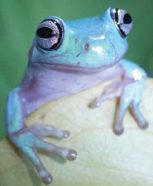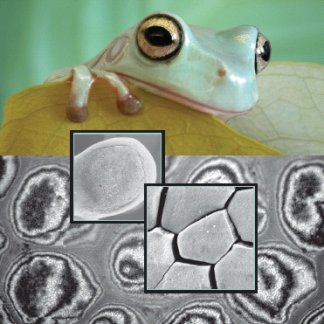Not Slippery When Wet
A tree frog's specially designed feet allow it climb wet or dry slopes.
By Emily Sohn
A gecko has amazingly sticky feet (see “How a Gecko Defies Gravity”). In fact, if you pull hard enough on a gecko stuck to a glass plate, you might break the plate. A tree frog’s foot doesn’t have so powerful a grip, but it still must allow the frog to climb wet, slippery leaves—sometimes while the frog is upside down.
Now, scientists have figured out how a tree frog manages to keep its grip.
 |
|
A tree frog’s toes can grip both wet and dry surfaces. |
| Thomas Endlein |
A tree frog’s foot is covered with a wet film. This layer of fluid led scientists to think that the frog’s wet toe pads cling to a surface by the same force that makes a damp piece of paper stick to a window. But this didn’t explain how a frog could walk on something wet, such as a rock in a stream or a branch in the rain.
To answer this question, Walter Federle of the University of Cambridge in England and a team of scientists took pictures of tree frogs walking on glass. By magnifying the pictures and making measurements, the researchers found that the wet layer on a frog’s foot is very thin. In some places, there’s no film at all.
It turns out that a tree frog has tiny bumps on the bottom of its feet, almost like soccer cleats. Because the wet film is so thin, these bumps poke through and stay dry, giving a tree frog better traction when climbing slippery surfaces.
A tree frog’s toe pads also have little channels along which fluid can flow. On wet surfaces, the channels funnel away extra fluid. On dry or uneven surfaces, they bring additional fluid to the pads, allowing the frog to cling more tightly or even hang upside down.
 |
|
A tree frog’s toe pad (upper inset) consists of six-sided skin cells (lower inset) that are covered with cleat-like bumps (bottom). |
| Thomas Endlein |
A gecko’s feet have inspired a new type of adhesive tape (see “Sticking Around with Gecko Tape”). If engineers can figure out how to imitate a tree frog’s foot, we might someday have car tires that stick to the road even when the road’s wet.—E. Jaffe
Comments:
I think this article includes a safety issue. If engineers
could find a way to make tires stick to the road on wet, rainy days, then
more cars could stay on the road and there would be fewer accidents. I hope
it happens soon, because there was just a huge accident in my area. Hope it
helps!—Emily, 11
Going Deeper:
Jaffe, Eric. 2006. Walking on water: Tree frog’s foot uses dual method to stick. Science News 169(June 10):356. Available at http://www.sciencenews.org/articles/20060610/fob3.asp .
McDonagh, Sorcha. 2004. Gooey secrets of mussel power. Science News for Kids (Jan. 21). Available at http://www.sciencenewsforkids.org/articles/20040121/Note2.asp .
______. 2003. Sticking around with gecko tape. Science News for Kids (June 11). Available at http://www.sciencenewsforkids.org/articles/20030611/Note2.asp .
Sohn, Emily. 2006. Microbe superglue. Science News for Kids (May 3). Available at http://www.sciencenewsforkids.org/articles/20060503/Note2.asp .
______. 2005. Geckos’ sticky feet clean themselves. Science News for Kids (Jan. 12). Available at http://www.sciencenewsforkids.org/articles/20050112/Note3.asp .
______. 2003. How a gecko defies gravity. Science News for Kids (Nov. 19). Available at http://www.sciencenewsforkids.org/articles/20031119/Feature1.asp .
Science project idea: Compare the adhesive strength of different kinds of tape (see http://www.sciencenewsforkids.org/articles/20060426/LZActivity.asp ).







